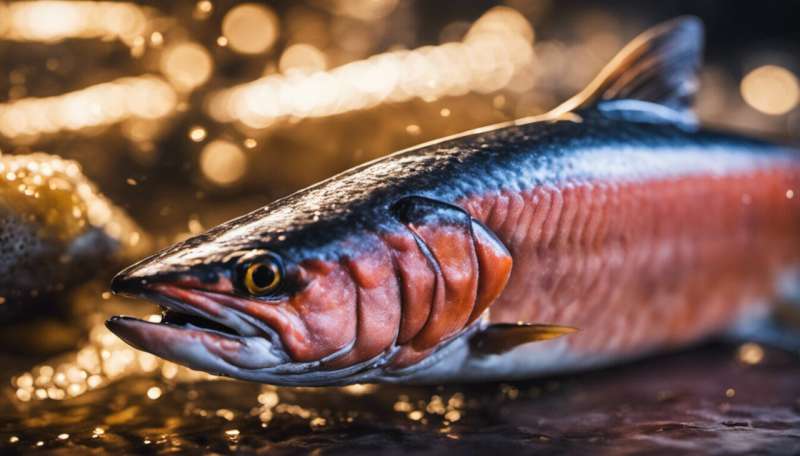This article has been reviewed according to Science X's editorial process and policies. Editors have highlighted the following attributes while ensuring the content's credibility:
fact-checked
trusted source
written by researcher(s)
proofread
The colour of farmed salmon comes from adding an antioxidant to their feed, with benefits for everyone

A barrage of messages from social media influencers, along with other online blogs and articles, have claimed that farmed salmon are bad for you because the fish are fed dyes to turn their flesh red.
Some have claimed that farmed salmon is naturally gray, suggesting they are malnourished, and consumers should avoid eating it for this reason.
These claims are utterly false and perpetuate a myth that can confuse or scare salmon consumers. The truth is that the colour of salmon fillets is red due to naturally occurring molecules called carotenoids, such as astaxanthin. This is part of a natural diet of wild salmon, and is added to the food for farmed salmon.
Carotenoids are common in the natural world among different plants and animals. Salmon have it in their diet from eating algae, krill and other small crustaceans. Carotenoids are essential pigments produced by bacteria, fungi, algae and plants. Animals cannot make carotenoids on their own, so those found in animals are either directly accumulated from food or partly modified through their own metabolic reactions.
The colour of salmon fillets is from the same pigment that we see in shrimp, lobsters and even flamingos.
Why are salmon red?
The red colour of salmon flesh—their muscle tissue—is a unique trait in several types of salmon. It's an evolved genetic trait that likely occurred as an evolutionary mutation and distinguishes salmon from other types of fish.
While the flesh colour is a direct result of carotenoids in their diet, there is also a unique genetic component. The gene beta-carotene oxygenase 1 is responsible for carotenoid metabolism, and most likely explains flesh colour variation in salmon.
Carotenoids, including astaxanthin, can be manufactured and added to the diet of farmed salmon. These can be produced synthetically on a commercial scale, or from natural sources, such as algae; the freshwater green microalgae, Haematococcus pluvialis, is a popular source. H. pluvialis is an excellent source of astaxanthin for farmed salmonids like rainbow trout.
More importantly, astaxanthin is a health-sustaining molecule that plays a critical role in fish health and survival, and has benefits for humans too.
Health benefits to fish
Astaxanthin is a potent antioxidant, meaning it prevents some types of cellular damage. Antioxidants have multiple health benefits for both fish and humans.
Astaxanthin's antioxidant activity is 100 times higher than vitamin E, which is a popular antioxidant in human supplements. In fish, it has many important functions related to immunity and reproduction.
Research has shown that astaxanthin has a significant impact on reproductive performance in many different fish species, like egg production and quality, sperm quality, fertilization rate and survival of newly hatched larvae.
Salmon eggs are red or orange in colour because of the accumulation of astaxanthin, which plays a beneficial role in protecting the eggs.
Astaxanthin plays an important role in immune function and enhances the production of antibodies and the proliferation of immune cells. It improves liver function in fish, increases defences against oxidative stress, serves as a source of vitamin A and boosts its activity in fish.
New Canadian research is underway to investigate the role of dietary astaxanthin in inflammatory control and immunity in Atlantic salmon. Overall, studies have consistently found that dietary astaxanthin is an important nutritional factor in stimulating growth and maintaining health and survival of aquatic animals.
Health benefits to humans
In humans, astaxanthin's antioxidant and anti-inflammatory effects have been shown to protect against stress-associated and inflammatory diseases. There are also potential effects on various diseases, including cardiovascular diseases, cancer, diabetes and obesity.
Additionally, pre-clinical trials predict that astaxanthin may regulate intestinal microbiome and glucose metabolism. People can get astaxanthin in their diet by eating salmon or other salmonids like trout as well as shrimp, crab, krill or supplements.
Astaxanthin in farmed fish feeds is not only for pigmentation, but is also a necessary nutrient for health and reproduction in fish. In turn, it increases the nutritional value of the fish fillets for consumers.
Provided by The Conversation
This article is republished from The Conversation under a Creative Commons license. Read the original article.![]()





















